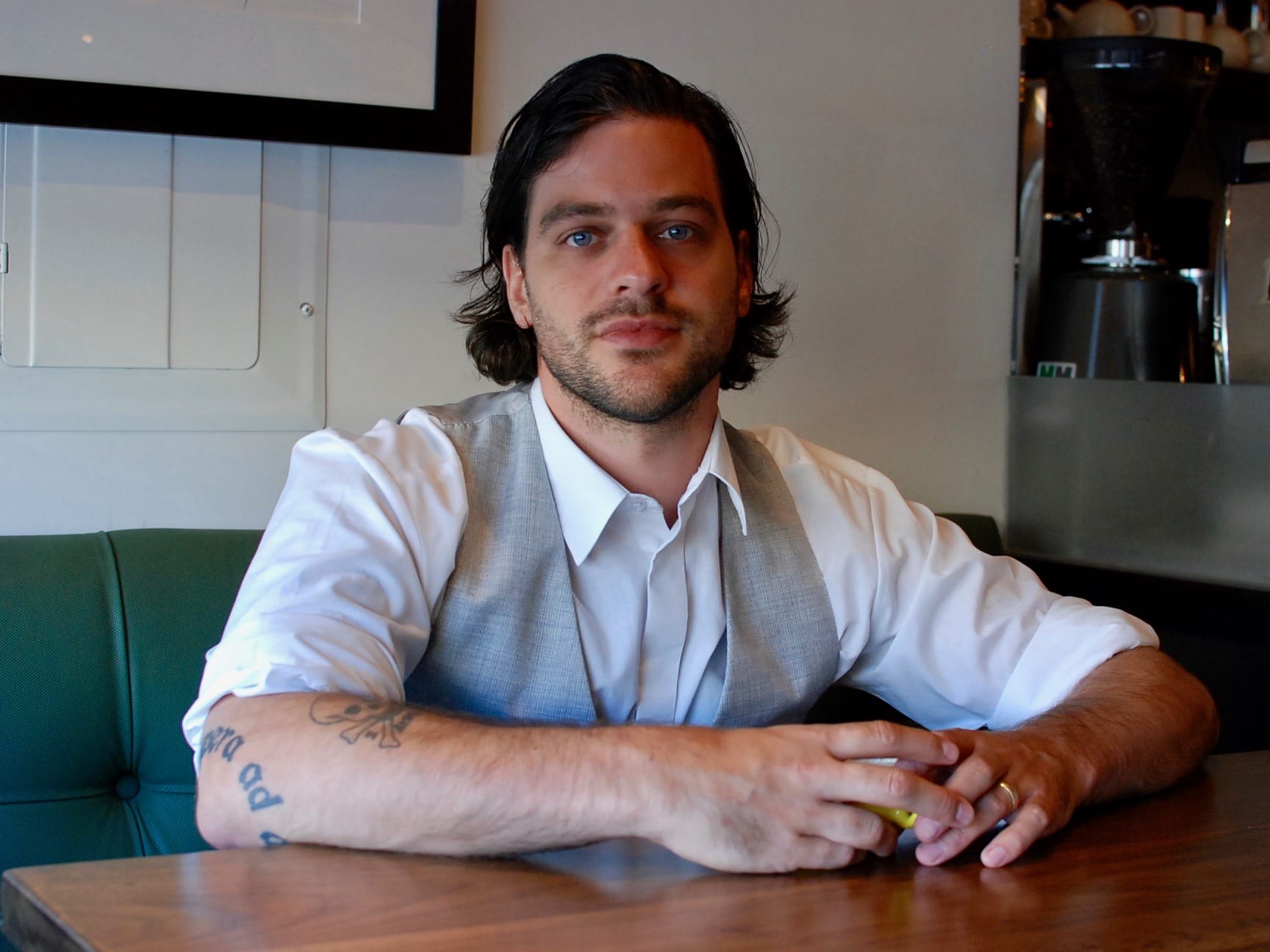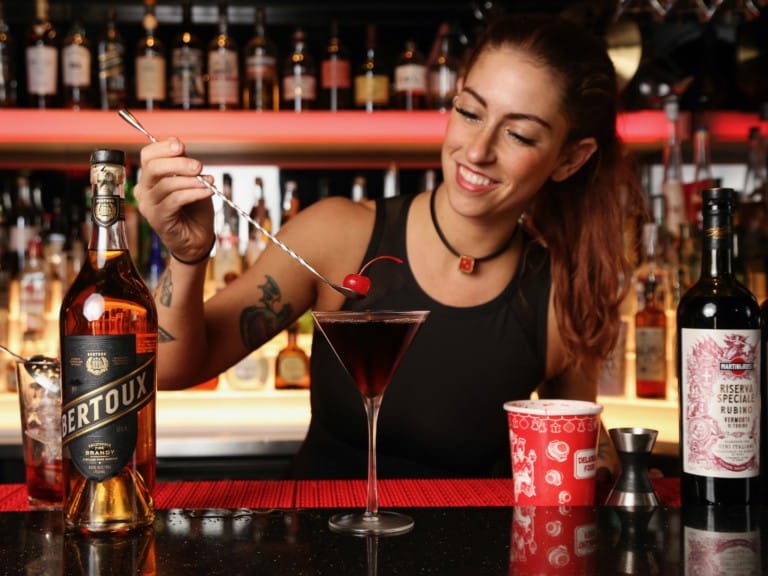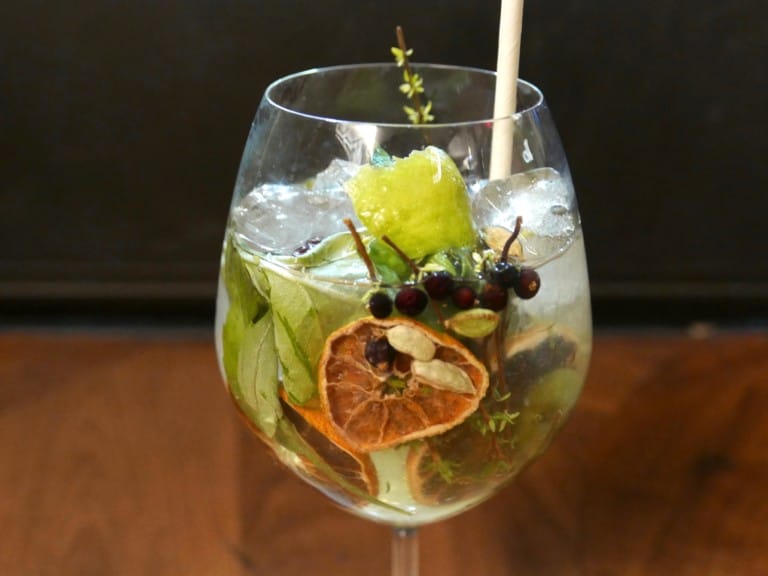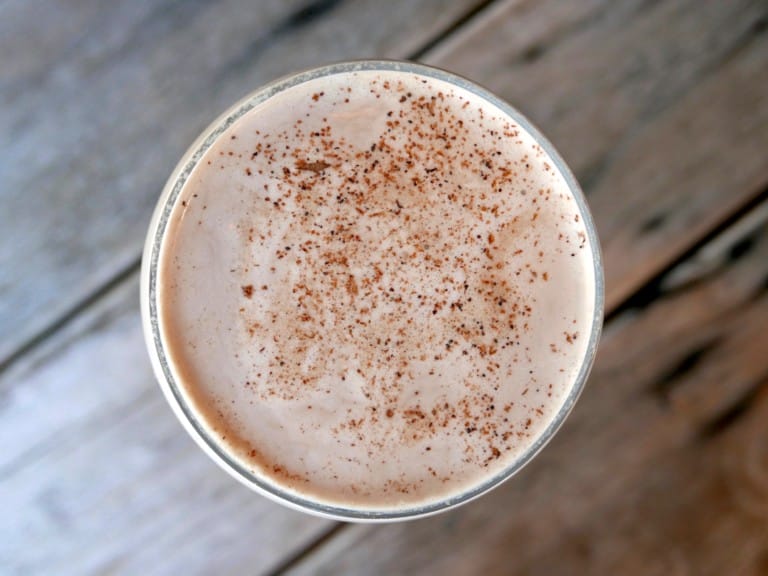INTERVIEW CONTINUED FROM PREVIOUS PAGE
JL: Do you have a first cocktail memory, good or bad?

Locanda Smoke & Spice and Nonna Del Diavolo
MSW: Yeah. My best memory was at Milk & Honey. I started in this group not having a single clue, pretending that I knew how to free-pour, and all night long, I stayed up, free-pouring. I Googled it – free-pour – I didn’t know. I didn’t speak English very well. I was lucky, because over here, I’d be made a barback, but over there, I was given a bartender’s job instantly, and I don’t know how that happened. But then I Googled it, “What is free-pouring?” I got myself a speed pour from the bar that I was at, and I was at home all night getting that shit right, and they tested me the day I got in. Then we had the busiest night we had in a year, so they didn’t have the time to watch how I worked. I’m a good actor, I can pretend I know what I’m doing. The drinks might not have tasted that right, but I always tasted them, adding citrus or sugar, made sure, because that was completely new to me. If you compare it to now though, I have five and a half years at my back. Back then I had nothing.
They had a big competition in my first week. It was called the Woodford Reserve Cup. This guy Kevin said, “Look, all you have to do is make an original drink and highlight the brand because the people that judge it, they’ll be looking for that.” So I made a drink which I think was very good with Woodford Reserve, and that was a big thing, because our company was the biggest retailer of Woodford Reserve bourbon in the world. So Woodford would pay for us to go out every year and blend our own bourbon, which was quite nice. We had our own blend of Woodford Reserve.
JL: From Kentucky?
MSW: Yeah. And I won this cup with this drink. I was like, “Shit, this is amazing, I’m going to go out and spend all this money that I won, with my friends.” We had oysters there, and kind of for the first time – because the amazing thing about our industry, even if you’re not a guy with a lot of money, you get to experience things that are a luxury – and that was my first proper memory. I went into Milk & Honey, in which I didn’t work at the time. I worked at Match, which was the same group. We had the same exams, but Milk & Honey always had that mysterious thing about it. It’s a speakeasy and open until 3 in the morning where Match was only open ‘til 1. Or we closed at midnight. I was really impressed going in there and people were making really nice drinks. Now I’m really down. And that’s when it clicked, and I was like, I now have to prove that I wasn’t just lucky. Because I was lucky to win the competition. I was the new guy, the young one, the 24-year-old, from Switzerland, barely spoke English, and I got lucky. Then I got the need to prove and back it up, and every day, I would be at home reading on every single book there is, cause Fraser – the fascinating thing about him – he owns pretty much the biggest library of anyone in the U.K. I drank up books, and I’d read and read and read and read about liquor, about wine. Ever since, all I’ve been trying to do is top what I’ve done.
JL: How are you trying to exceed expectations here?
MSW: What I’m trying to do here is – I’m really lucky because Eric implemented that program – exceed the expectation of what people in San Francisco have of what we can do in a restaurant setting. And I would say in a Grade A restaurant setting, because the prices reflect that. So you can compare it to what the guys have done at Range, or you can compare it to Beretta or Nopa, but then what we’re trying to do, there’s an actual theme. Don’t call it a theme, but because it’s blatantly Italian – it’s Roman – and there’s a lot of research that we had to do, that Eric especially had to do, to figure out what we need to do to be cutting-edge. You can’t be behind. What we every day try to do is to get especially industry people to come in – and they’re very critical in this city – and convince them that we’re doing a nice thing. We’re doing a simple thing; we don’t have more than six drinks on the menu. That’s a new thing. The bartender’s choice highlights our craft, cause we know what we’re doing, but no one is highlighting it.
What I find funny – you go to Bourbon & Branch for example – and Milk & Honey was the same – so Milk & Honey London, you had like 60 drinks in it, but that’s all we would make, mainly. Mainly. In Milk & Honey New York, there was no menu, but Milk & Honey New York was not as high volume. It was one floor, 30 customers you look after, one bartender, one server, done. Us in London, when I was running it, it was four floors and a total of 10 staff at the time, so you obviously don’t have that much time to spend with each customer.
JL: What’s the criteria for a cocktail that goes on the list at Locanda?
MSW: It has to have an Italian sort of context, so either you use an Italian ingredient, or it’s presented in the Italian style – being, like I said earlier – a digestif or aperitif. There’s not really any during-dinner drinks. In Italy, you don’t drink cocktails during dinner. It’s a new concept for me. That’s something I haven’t even met in London. It’s very strange. In London, you have cocktails as a celebration before or after dinner, but here, people are pairing. It’s interesting. Cause I like to see cocktails with wine. I want to do that a bit more. Wine is why I moved out here. At this company, The Match Bar Group in London, we opened a space called the East Room, which is where we provided a whole range of Milk & Honey drinks in a club setting, but there was a restaurant upstairs, and then there was a rooftop. There was a club downstairs, and then there was a basement club. So it was five levels. It was crazy.
JL: What was the most recent cocktail that you developed for Locanda, and what was your inspiration?
MSW: Eric has done all those drinks, but we feel like now, two months in, you’ve got to keep changing. We brought in three new ones a month ago, and they’re selling really well. One was the aperitivo, which is Campari, orange, lemon, Prosecco, but really simple. People love it. It sells because it looks nice on the menu. There are always two factors to a drink being good, I think. One is it reads nice on the menu. Hence the expectation is really high. Then the second is the surprise effect. It doesn’t look nice on the menu, but then you drink it and you’re like, “Oh, I didn’t think I liked gin.” Do you know what I mean?
JL: Yep.
MSW: So I put that on. We put on one that they did at Little Branch, one of Eric’s drinks, which was Aperol, cucumber and gin, and that works really well. That’s new, and then we put on one called Fernet #3, and that has Fernet in it, brandy – it’s almost like a Harvard – so a brandy Manhattan, but with Fernet instead of bitters. That works quite nice as well.
JL: Fernet seems to be very popular in San Francisco.
MSW: It’s crazy, but you know what, that’s kind of our trump, because we’ve got all these amaros. We’ve got 17, the biggest range in the city, and I keep trying to get new ones, so we’ve got that big range or amaros. I need to show you what I’ve done – it’s crazy – just to show you what we plan to do.
[Sager-Wilde grabs a notebook with a map of Italy]
What matters is origin, so we’ve got this. It’s not enough if they say, “Hey, this amaro is from Veneto.” They’ve got to know where it is.
[Sager-Wilde flips to a page with an amaro axis.]
Then I’ve done on this sheet, a month ago – cause I was like, we’ve got all these amaros, and they are selling, but we need to know about them big time – so I sat down, tasted them all and put them in a dry to sweet, bright fruit, red fruit, etc., a gradient.
JL: Up to herbal?
MSW: Yeah.
JL: So it’s an axis.
MSW: Yeah, it kind of works that way. You can always place them here. You rarely find one that’s spicy and bright fruit. You don’t find it. You find spice, say cinnamon, clove, etc. Combined with mint, camphor, all those herbal characteristics. Or you can find coffee, maccha, etc. Either way, so last week I’ve done a drink with amaro, because I was like, we don’t have a proper amaro drink on there except for the Fernet #3, and I like it, but not that much. So I made one with Meletti. I smelled the amaro and thought, It’s sweet, so I’m going to need less sugar, obviously, in the drink. I might even ditch the sugar. And it’s bright fruit, meaning it’s orange, apricot, etc. What spirit am I going to use? I tried rum. It didn’t really work, so I was thinking, I’m going to go bourbon. That’s what I did. I did a bourbon sour with Meletti and grapefruit. And the drink is crazy…We’re trying to understand what we have by looking through it with a California focus, if you see what I mean. So we’re trying to look at these Italian spirits – [points to axis]…You’re talking a sweetness range I haven’t seen in any other spirit. It’s mad. And then the range of characters, you’ll rarely find bourbons that herbal with bright fruit. They’re also in the middle somewhere. The same with rums. Rums are probably the next most versatile, but they’re still not as versatile as this. They don’t have as much of a sweetness range.
JL: That’s pretty handy.
MSW: Yeah. It fascinates me, and I didn’t know about that. That’s what I’m trying to tell you. With what we’re doing here, we can change perception with that focal point.
JL: Who are some other bartenders that you really respect, who you have not worked with before?
MSW: In this city?
JL: It could be anywhere.
MSW: I like what they do at Nopa a lot. A lot. The actual hospitality seems to be much better.
JL: Than London?
MSW: Than London, yeah. And there’s more of a friendship character to it. You’re made to feel like you’re a friend, and not just a customer, which is very interesting. They’re trying to look after you in a nice way. I like the people at Nopa a lot. I did like Beretta a lot as well. They’re kind of my favorite two spots. That’s for cocktails. For food, that changes. Nopa is the only place that has kickass food and kickass cocktails.
JL: Where and what do you like to drink when you’re not working?
MSW: Because I moved to California and I’ve got this access to beer, you’ve got San Diego and you’ve got Portland. It’s crazy. I drove all the way to Portland just to see those microbreweries.
JL: Nice.
MSW: All the way, 16 hours, I didn’t care. And I went to Bend to see Deschutes Brewery, all the way down. I love drinking beer.
JL: Where do you like to drink it?
MSW: Toronado, of course. I like to drink at Toronado. I like to drink the Basque cider that they have at Nopa, because I’ve never seen it before. They have this bone-dry Basque cider that they pour high, and it just aerates. Nobody here drinks cider. I miss it from London. I’d have Basque cider all the time, but here they have this new view, they pour it differently. It’s pretty cool. Where else do I drink beer? I like beer at Hideout and at Dalva. They’ve got a nice Russian River Brewing selection, and they’ve got some Santa Rosa…
JL: Moonlight?
MSW: Yeah, Moonlight Brewing, it’s pretty amazing. Other than that, I’ve been up to wine country four times since I’ve been here to see wineries, so really wine and beer.
JL: How do you find balance in your career?
MSW: I find a crazy balance between my personal time and my working time. It seems that here you’re fine working 50 hours, but in New York and London, they’ll tell you – I’ve seen you interviewed Erik Lorincz – he must be working 60 or 70 hours. He was back when we met. The same, Eric, he would have told you, back in New York, he worked crazy hours. You just do. They’re open later, and they pay you less per hour, so you need to make more money. My newly found balance is that I get to enjoy the benefits and perks of my job more because I have more time off. I find balance in being able to drive up to Mount Shasta on my two days off. If you’re in London, you’re kind of stuck because you have to take a plane everywhere. Whereas here you can drive to San Diego, to L.A. You know how it is. You can drive it, seven hours, eight hours, you’re there. That fascinates me. That’s kind of my balance. So balance between the location, and I can escape that location if I want to, and that’s great in a concrete jungle, and balance of time at work and outside of work.
JL: What’s a cocktail you recommend people make at home?
MSW: I like punches. I like Pisco punch. I like Pisco punch a lot because it’s so easy to do. You just make pineapple gomme, which is real easy to do, or you make your pineapple marinade. You make slices of grapefruit, slices of cloves and then slices of pineapple, and another slice of clove, another slice of grapefruit, etc., and then just put sugar and water, you get the most crazy, crazy marinade, and all you do is that with Champagne and lemon and you’re done. You don’t have to know anything about drinks, and it serves – it’s a man’s drink, but also a girl’s drink. People recommend making Manhattan or Old Fashioned at home, but it might not taste that nice if you have bad ice.
JL: If you could only drink one more cocktail…
MSW: …Whoa!…
JL: …What would be in the glass?
MSW: Wow is this tough. Not a spirit? It would have to be a cocktail? I couldn’t say. I’ve never thought about that. What do people usually say to that? I don’t know. One more? Right now, if I would die right now, I would make myself that Meletti drink. I think about novelty factor. Why order one drink? When I go out, I love daiquiris.
JL: Who would make your daiquiri?
MSW: Kevin, in London. He makes it the best. He does. He’s got that perfect balance, where it’s not too spirituous, not too watery, not too sour, not too sweet, it’s not too diluted or not too strong. Or Argo Peroni in the hotel. Or Erik. They know how to make daiquiris. That’s their life. They’re crazy. They make daiquiris all day long. It’s different than here. Here nobody drinks daiquiris. I miss it. It’s a white spirit, clean refreshing drink. What I miss, we don’t have Havana Club here.









Leave a Comment